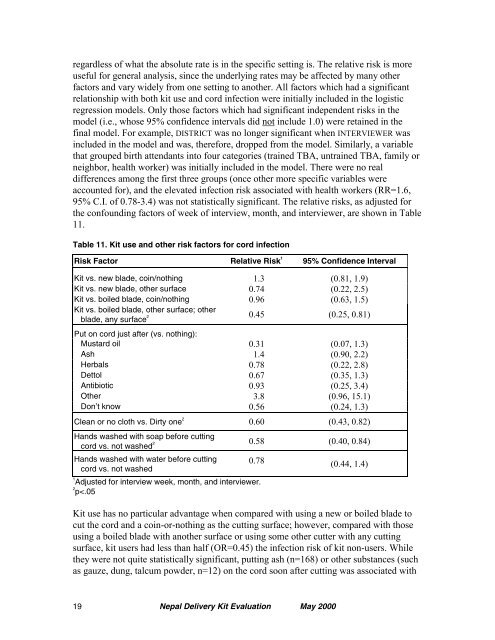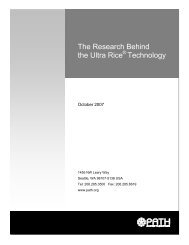Nepal Clean Home Delivery Kit: Evaluation of the Health Impact - Path
Nepal Clean Home Delivery Kit: Evaluation of the Health Impact - Path
Nepal Clean Home Delivery Kit: Evaluation of the Health Impact - Path
Create successful ePaper yourself
Turn your PDF publications into a flip-book with our unique Google optimized e-Paper software.
egardless <strong>of</strong> what <strong>the</strong> absolute rate is in <strong>the</strong> specific setting is. The relative risk is more<br />
useful for general analysis, since <strong>the</strong> underlying rates may be affected by many o<strong>the</strong>r<br />
factors and vary widely from one setting to ano<strong>the</strong>r. All factors which had a significant<br />
relationship with both kit use and cord infection were initially included in <strong>the</strong> logistic<br />
regression models. Only those factors which had significant independent risks in <strong>the</strong><br />
model (i.e., whose 95% confidence intervals did not include 1.0) were retained in <strong>the</strong><br />
final model. For example, DISTRICT was no longer significant when INTERVIEWER was<br />
included in <strong>the</strong> model and was, <strong>the</strong>refore, dropped from <strong>the</strong> model. Similarly, a variable<br />
that grouped birth attendants into four categories (trained TBA, untrained TBA, family or<br />
neighbor, health worker) was initially included in <strong>the</strong> model. There were no real<br />
differences among <strong>the</strong> first three groups (once o<strong>the</strong>r more specific variables were<br />
accounted for), and <strong>the</strong> elevated infection risk associated with health workers (RR=1.6,<br />
95% C.I. <strong>of</strong> 0.78-3.4) was not statistically significant. The relative risks, as adjusted for<br />
<strong>the</strong> confounding factors <strong>of</strong> week <strong>of</strong> interview, month, and interviewer, are shown in Table<br />
11.<br />
Table 11. <strong>Kit</strong> use and o<strong>the</strong>r risk factors for cord infection<br />
Risk Factor Relative Risk 1 95% Confidence Interval<br />
<strong>Kit</strong> vs. new blade, coin/nothing 1.3 (0.81, 1.9)<br />
<strong>Kit</strong> vs. new blade, o<strong>the</strong>r surface 0.74 (0.22, 2.5)<br />
<strong>Kit</strong> vs. boiled blade, coin/nothing 0.96 (0.63, 1.5)<br />
<strong>Kit</strong> vs. boiled blade, o<strong>the</strong>r surface; o<strong>the</strong>r<br />
2<br />
blade, any surface<br />
0.45 (0.25, 0.81)<br />
Put on cord just after (vs. nothing):<br />
Mustard oil 0.31 (0.07, 1.3)<br />
Ash 1.4 (0.90, 2.2)<br />
Herbals 0.78 (0.22, 2.8)<br />
Dettol 0.67 (0.35, 1.3)<br />
Antibiotic 0.93 (0.25, 3.4)<br />
O<strong>the</strong>r 3.8 (0.96, 15.1)<br />
Don’t know 0.56 (0.24, 1.3)<br />
<strong>Clean</strong> or no cloth vs. Dirty one 2 0.60 (0.43, 0.82)<br />
Hands washed with soap before cutting<br />
2<br />
cord vs. not washed<br />
0.58 (0.40, 0.84)<br />
Hands washed with water before cutting<br />
cord vs. not washed<br />
0.78 (0.44, 1.4)<br />
1<br />
Adjusted for interview week, month, and interviewer.<br />
2<br />
p
















